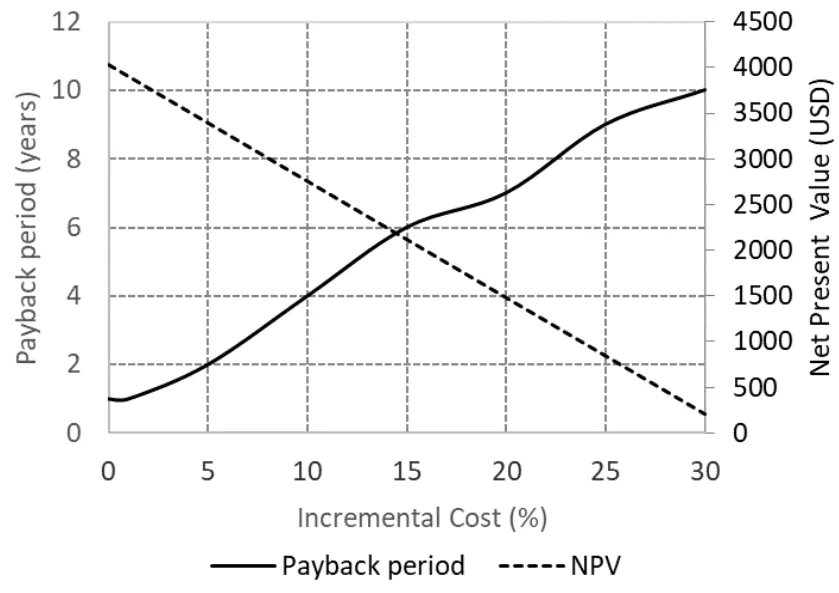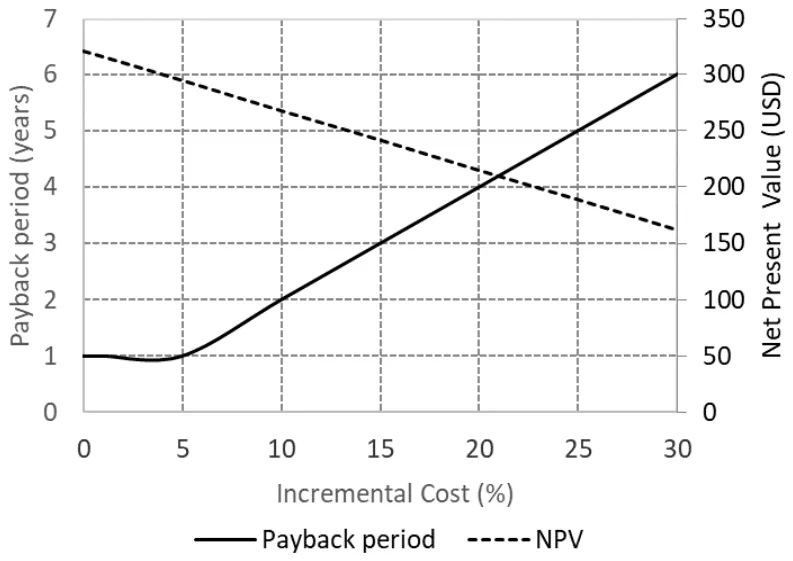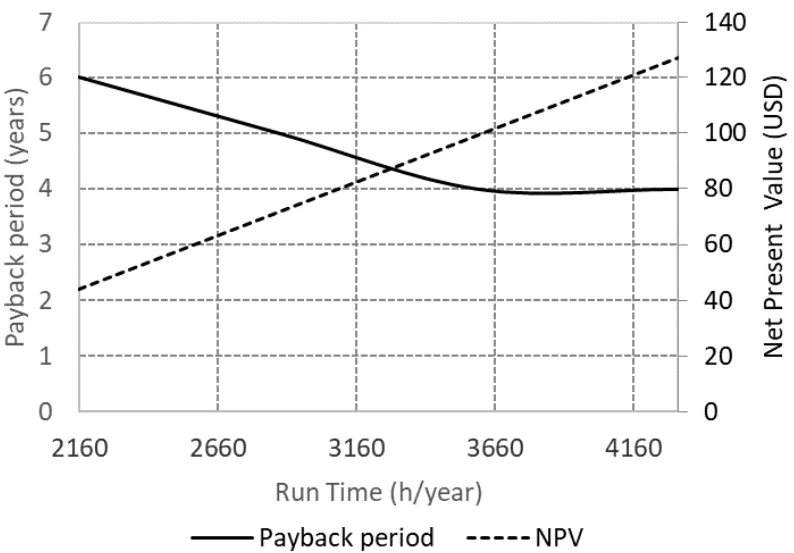이 소개 논문의 내용은 [논문 제목: Induction motors with copper rotor: a new opportunity for increasing motor efficiency]을 [출판사: International Journal of Electrical and Computer Engineering (IJECE)]에서 발행한 논문을 기반으로 합니다.

1. 개요:
- 제목: 구리 로터를 사용한 유도 전동기: 모터 효율을 높이는 새로운 기회
- 저자: Percy R. Viego Felipe, Vladimir Sousa Santos, Julio R. Gómez Sarduy, José P. Monteagudo Yanes, Enrique Ciro Quispe
- 출판 연도: 2023
- 출판 저널/학회: International Journal of Electrical and Computer Engineering (IJECE)
- 키워드: 구리 로터 유도 전동기, 경제적 타당성, 전기 모터, 에너지 효율, 고효율 모터
2. 초록:
구리 로터 유도 전동기(CURIM)는 알루미늄 로터(ALRIM)보다 로터 융합 손실이 적기 때문에 최근에 도입되었습니다. 또한 CURIM을 사용하면 IE4 및 IE5 효율 수준에 더 쉽게 도달할 수 있습니다. CURIM은 소형 모터, 에스컬레이터 및 전기 자동차 애플리케이션에 유리합니다. 그러나 CURIM은 슬립, 역률, 온도 상승 및 토크 감소 문제를 나타내므로 분석해야 합니다. 본 연구에서는 할인 기법을 적용하여 CURIM과 ALRIM을 사용하는 경제적 타당성을 비교했습니다. 순환 작동이 있는 설탕 회사에서 사례 연구를 수행했으며, 여기서 5.5kW 모터가 제분기 공급 장치의 중간 도체에 설치됩니다. 이 시설은 3~6개월 동안 3교대로 운영됩니다. ALRIM에 대한 CURIM의 비용 증가(ACI)는 1.1~1.5배였습니다. 3,600시간/년 및 4,000시간/년 작동 시 ACI가 10%보다 크면 투자 회수 기간이 4년 이상이고 순 현재 가치(NPV)가 선형적으로 증가하는 것으로 나타났습니다.
3. 서론:
알루미늄 로터 유도 전동기(ALRIM) 대신 구리 로터 유도 전동기(CURIM)를 사용하면 로터 손실을 크게 줄일 수 있습니다. 이는 주로 구리의 전기 전도도가 알루미늄의 약 170%이기 때문입니다. 따라서 전체 기계 손실도 감소합니다. 중전력 유도 전동기에서 총 손실의 15%~25%에서 효율이 2%~5% 증가합니다[1], [2]. 그러나 알루미늄에 비해 구리의 높은 용융 온도(구리의 경우 1,083°C, 알루미늄의 경우 660°C)로 인해 구리 주조 공정에 대한 문제가 먼저 해결되어야 했습니다. 나타난 근본적인 어려움은 다이 수명 단축, 순수 구리 주조 공정에서의 산화, 용융 구리에 분산된 다공성이었습니다[2].
전력 비용이 증가함에 따라 모터 수명 주기 비용이 필수적이라는 인식이 높아졌고 소비자는 더 효율적인 모터에 더 높은 초기 비용을 지불하는 편의성을 인식했습니다[3]. 또한 정부 규제 및 인센티브가 추진 요인이었습니다. 따라서 많은 회사와 협회에서 구리 주조의 단점을 제거하기 위해 노력했으며 로터 제조를 위한 다이 재료 및 주조 공정을 개발하여 대량 생산이 가능하고 경제적이 되었습니다[1], [2], [4].
4. 연구 요약:
연구 주제 배경:
구리 로터 유도 전동기(CURIM)는 알루미늄 로터(ALRIM)보다 로터 융합 손실이 적기 때문에 최근에 도입되었습니다. 또한 CURIM을 사용하면 IE4 및 IE5 효율 수준에 더 쉽게 도달할 수 있습니다. CURIM은 소형 모터, 에스컬레이터 및 전기 자동차 애플리케이션에 유리합니다.
기존 연구 현황:
알루미늄에 비해 구리의 높은 용융 온도(구리의 경우 1,083°C, 알루미늄의 경우 660°C)로 인해 구리 주조 공정에 대한 문제가 먼저 해결되어야 했습니다. 나타난 근본적인 어려움은 다이 수명 단축, 순수 구리 주조 공정에서의 산화, 용융 구리에 분산된 다공성이었습니다[2].
연구 목적:
본 논문에서는 구성 특성 및 관련 비용, 작동, 손실, 전기 기계, 에너지 및 온도 특성을 기반으로 CURIM과 ALRIM을 비교합니다. 마지막으로, 동일한 용량의 ALRIM으로 CURIM을 교체한 결과를 비교하여 설탕 공장에서 5.5kW 모터를 교체하는 경제적 타당성 연구를 수행합니다.
핵심 연구:
CURIM의 구리 주조 공정에 대한 연구는 제조업체에서 제작한 특정 유형(즉, 정격 전력, 극수, 전압)의 구리 로터 모터를 설계, 주조 및 설치하는 비용이 다른 제조업체의 비용과 다를 수 있음을 나타냅니다.
5. 연구 방법론:
연구 설계:
순환 작동이 있는 설탕 회사에서 사례 연구를 수행했으며, 여기서 5.5kW 모터가 제분기 공급 장치의 중간 도체에 설치됩니다. 이 시설은 3~6개월 동안 3교대로 운영됩니다.
데이터 수집 및 분석 방법:
경제 분석은 차등 순 현재 가치(Differential NPV)[27] 기준을 사용하여 사례 연구에서 수행되었으므로 동일하거나 거의 동일한 비용(예: 고정자 비용, 설치 비용, 유지 보수 비용)이 제거됩니다.
연구 주제 및 범위:
동일한 용량의 ALRIM으로 CURIM을 교체한 결과를 비교하여 설탕 공장에서 5.5kW 모터를 교체하는 경제적 타당성 연구를 수행합니다.
6. 주요 결과:
주요 결과:
- 표 1. 11.2kW CURIM 7개의 평균 손실 분리 [5]
- 표 2. 11.2kW 모터의 기타 성능 특성 [5]
- 표 3. 11.2kW 모터의 측정된 토크 값 [5]
- 표 4. ALRIM과 비교한 다양한 CURIM의 효율 증가 및 총 손실 감소 [5]
- 표 5. Al 및 Cu 소형 로터 75kW 모터 비교 [2]
- 표 6. 11kW, 6극 에스컬레이터 구리 로터 모터의 매개변수 [2]
- 표 7. 160kW 전기 자동차의 매개변수 [2]
- 표 8. 5.5kW 모터에 대한 차등 NPV 방법을 사용한 경제 분석 매개변수 [27]



그림 제목 목록:
- 그림 1. 4,000시간 작동에 대한 초기 증분 비용으로 NPV 및 투자 회수 기간 함수
- 그림 2. 초기 차등 비용 및 8,000시간 작동의 함수로 NPV 및 투자 회수 기간
- 그림 3. 초기 증분 비용 및 가변 작동 시간의 함수로 NPV 및 투자 회수 기간
7. 결론:
본 연구에서는 에너지 효율을 높이기 위한 유도 전동기의 새로운 기술 개선 중 하나인 CURIM의 장점과 단점을 평가했습니다. 그 결과 로터, 마찰 및 구동의 구리 손실과 추가 손실이 ALRIM보다 CURIM에서 더 낮고 따라서 효율이 더 높다는 것을 보여줄 수 있었습니다.
8. 참고 문헌:
- [1] D. Liang, J. Yu, X. Yang, and V. Zhou, "Copper rotor motors in China," in 2013 International Conference on Electrical Machines and Systems (ICEMS), Oct. 2013, pp. 2031-2034, doi: 10.1109/ICEMS.2013.6713191.
- [2] D. Liang, L. Gao, and V. Zhou, "Recent trend development for high performance copper rotor motors in China," in 2018 21st International Conference on Electrical Machines and Systems (ICEMS), Oct. 2018, pp. 2571-2575, doi: 10.23919/ICEMS.2018.8549253.
- [3] S. Lie and C. Di Pietro, "Copper die-cast rotor efficiency improvement and economic consideration," IEEE Transactions on Energy Conversion, vol. 10, no. 3, pp. 419-424, 1995, doi: 10.1109/60.464863.
- [4] D. Liang, X. Yang, J. Yu, and V. Zhou, "Experience in China on the die-casting of copper rotors for induction motors," in 2012 XXth International Conference on Electrical Machines, Sep. 2012, pp. 256-260, doi: 10.1109/ICElMach.2012.6349874.
- [5] D. T. Peters, J. G. Cowie, E. F. Brush, and D. J. Van Son, "Copper in the squirrel cage for improved motor performance," in IEEE International Electric Machines and Drives Conference 2003, IEMDC'03, vol. 2, 2002, pp. 1265-1271, doi: 10.1109/IEMDC.2003.1210402.
- [6] S. Yamamoto, "Overview of the latest research and development for copper die-cast squirrel-cage rotors," in 2018 International Power Electronics Conference (IPEC-Niigata 2018 -ECCE Asia), May 2018, pp. 1949-1954, doi: 10.23919/IPEC.2018.8507971.
- [7] D. Liang and V. Zhou, "Recent market and technical trends in copper rotors for high-efficiency induction motors," in 2018 International Power Electronics Conference (IPEC-Niigata 2018 -ECCE Asia), May 2018, pp. 1943-1948, doi: 10.23919/IPEC.2018.8507879.
- [8] M. Thieman, R. Kamm, and J. Jorstad, "Copper motor rotors: Energy saving efficiency, now also economic feasibility," in 2007 Electrical Insulation Conference and Electrical Manufacturing Expo, Oct. 2007, pp. 328-333, doi: 10.1109/EEIC.2007.4562637.
- [9] R. Yabiku, R. Fialho, L. Teran, A. Santos, E. Rangel, and D. Dutra, "A comparative study between copper and aluminum induction squirrel cage constructions," in 2010 Record of Conference Papers Industry Applications Society 57th Annual Petroleum and Chemical Industry Conference (PCIC), Sep. 2010, pp. 1-9, doi: 10.1109/PCIC.2010.5666832.
- [10] ANSI, "Motors and generators," NEMA, 2016, Accessed Feb. 02, 2022. [Online]. Available: https://www.nema.org/docs/default-source/standards-document-library/ansi_nema-mg-1-2016-contents-and-foreword.pdf?sfvrsn=f27547b8_1
- [11] D. T. Peters, E. F. Brush, and J. L. Kirtley, "Die-cast copper rotors as strategy for improving induction motor efficiency," in 2007 Electrical Insulation Conference and Electrical Manufacturing Expo, Oct. 2007, pp. 322-327, doi: 10.1109/EEIC.2007.4562636.
- [12] Q. Zhang, H. Liu, Z. Zhang, and T. Song, "A cast copper rotor induction motor for small commercial EV traction: Electromagnetic design, analysis, and experimental tests," CES Transactions on Electrical Machines and Systems, vol. 2, no. 4, pp. 417-424, Dec. 2018, doi: 10.30941/CESTEMS.2018.00053.
- [13] M. Popescu, N. Riviere, G. Volpe, M. Villani, G. Fabri, and L. di Leonardo, "A copper rotor induction motor solution for electrical vehicles traction system," in 2019 IEEE Energy Conversion Congress and Exposition (ECCE), Sep. 2019, pp. 3924-3930, doi: 10.1109/ECCE.2019.8912248.
- [14] V. Mallard, G. Parent, C. Demian, J.-F. Brudny, and A. Delamotte, "Increasing the energy efficiency of induction machines by the use of grain-oriented magnetic materials and die casting copper squirrel cage in the rotor," IEEE Transactions on Industry Applications, vol. 55, no. 2, pp. 1280-1289, Mar. 2019, doi: 10.1109/TIA.2018.2873532.
- [15] A. Marfoli, M. Di Nardo, M. Degano, C. Gerada, and W. Chen, "Rotor design optimization of squirrel cage induction motor-part I: problem statement," IEEE Transactions on Energy Conversion, vol. 36, no. 2, pp. 1271-1279, Jun. 2021, doi: 10.1109/TEC.2020.3019934.
- [16] M. Di Nardo, A. Marfoli, M. Degano, C. Gerada, and W. Chen, "Rotor design optimization of squirrel cage induction motor-part II: results discussion," IEEE Transactions on Energy Conversion, vol. 36, no. 2, pp. 1280-1288, Jun. 2021, doi: 10.1109/TEC.2020.3020263.
- [17] D. Fodorean, C.-V. Pop, and D.-C. Popa, "Electromagnetic and structural analysis of an induction motor with copper rotor bars used in automotive applications," in 2021 IEEE 6th International Forum on Research and Technology for Society and Industry (RTSI), Sep. 2021, pp. 340-345, doi: 10.1109/RTSI50628.2021.9597235.
- [18] A. T. De Almeida, F. J. T. E. Ferreira, and A. Q. Duarte, "Technical and economical considerations on super high-efficiency three-phase motors," IEEE Transactions on Industry Applications, vol. 50, no. 2, pp. 1274-1285, Mar. 2014, doi: 10.1109/TIA.2013.2272548.
- [19] P. R. Viego, J. R. Gómez, and E. A. Padrón, "New syncronous high-efficiency motors," Universidad y Sociedad, vol. 12, no. 2, pp. 205-211, 2020. Accessed Jan. 21, 2022. [Online]. Available: http://scielo.sld.cu/scielo.php?script=sci_arttext&pid=S2218-36202020000200205&lng=es&tlng=es
- [20] P. R. Viego-Felipe, J. R. Gómez-Sarduy, V. Sousa-Santos, and E. C. Quispe-Oqueña, "Permanent magnet assisted synchronous reluctance motors: A new advance in electric motors development," (in Spanish), Ingeniería, investigación y tecnología, vol. 19, no. 3, pp. 269-279, Jul. 2018, doi: 10.22201/fi.25940732e.2018.19n3.023.
- [21] P. R. Viego, V. Sousa, J. R. Gómez, and E. C. Quispe, "Direct-on-line-start permanent-magnet-assisted synchronous reluctance motors with ferrite magnets for driving constant loads," International Journal of Electrical and Computer Engineering (IJECE), vol. 10, no. 1, pp. 651-659, Feb. 2020, doi: 10.11591/ijece.v10i1.pp651-659.
- [22] G. C. Mechler, "Manufacturing and cost analysis for aluminum and copper die cast induction motors for GM's powertrain and R&D Divisions," Thesis, Massachusetts Institute of Technology, 2010.
- [23] A. Marfoli, M. DiNardo, M. Degano, C. Gerada, and W. Jara, "Squirrel cage induction motor: a design-based comparison between aluminium and copper cages," IEEE Open Journal of Industry Applications, vol. 2, pp. 110-120, 2021, doi: 10.1109/OLA.2021.3073820.
- [24] H.-R. Noh, H.-S. Shin, C.-M. Kim, and K.-C. Kim, "A study on the effect of rotor bars of induction motor for electric vehicle," in 2021 24th International Conference on Electrical Machines and Systems (ICEMS), Oct. 2021, pp. 1415-1418, doi: 10.23919/ICEMS52562.2021.9634599.
- [25] Ministerio de Justicia, "System for the formation of electricity rates for the collection of electricity service: Gaceta Oficial No. 26," (in Spanish) Gaceta Oficial No. 26 (Extraordinaria), La Habana, Cuba, 2021. Accessed: Apr. 13, 2021. [Online]. Available: https://www.gacetaoficial.gob.cu/sites/default/files/goc-2021-ex26_0_0.pdf.
- [26] J. C. Andreas, Energy-efficient electric motors: selection and application. United States: Marcel Dekker, Inc., New York, NY, 1982.
- [27] M. J. Landt and A. D. Reed, "Project evaluation," in Archaeological Data Recovery in the Piceance and Wyoming Basins of Northwestern Colorado and Southwestern Wyoming, Archaeopress Publishing Ltd, 2018, pp. 333-336.
- [28] Siemens Industry, "General purpose low voltage cast iron frame motors," Siemens Industry, USA, 2011. Accessed Dec. 13, 2021. [Online]. Available: https://assets.new.siemens.com/siemens/assets/api/uuid:ff39a5d9-875a-4f16-bf17-79beae7a11c7/nema-general-purpose-motors-cast-iron-gp100-brochure.pdf
- [29] R. Saidur and T. M. I. Mahlia, "Energy, economic and environmental benefits of using high-efficiency motors to replace standard motors for the Malaysian industries," Energy Policy, vol. 38, no. 8, pp. 4617-4625, Aug. 2010, doi: 10.1016/j.enpol.2010.04.017.
- [30] B. Cassoret, J. Manata, V. Mallard, and D. Roger, "Comparative life cycle assessment of induction machines made with copper-cage or aluminium-cage rotors," IET Electric Power Applications, vol. 13, no. 6, pp. 712-719, Jun. 2019, doi: 10.1049/iet-epa.2018.5401.
9. 저작권:
- 이 자료는 "[Percy R. Viego Felipe]"의 논문입니다. "[Induction motors with copper rotor: a new opportunity for increasing motor efficiency]"를 기반으로 합니다.
- 논문 출처: [DOI: 10.11591/ijece.v13i3.pp2409-2418]
이 자료는 위 논문을 기반으로 요약되었으며, 상업적 목적으로 무단 사용하는 것을 금지합니다.
Copyright © 2025 CASTMAN. All rights reserved.